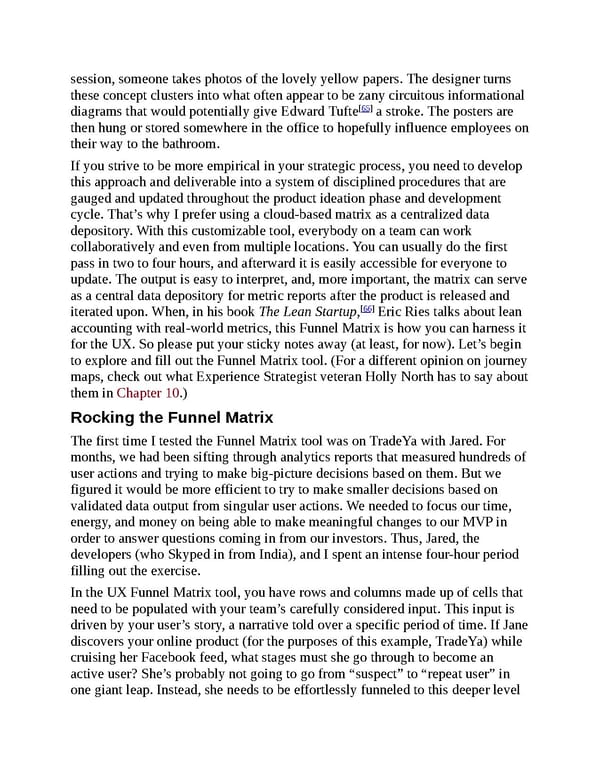session, someone takes photos of the lovely yellow papers. The designer turns these concept clusters into what often appear to be zany circuitous informational [65] diagrams that would potentially give Edward Tufte a stroke. The posters are then hung or stored somewhere in the office to hopefully influence employees on their way to the bathroom. If you strive to be more empirical in your strategic process, you need to develop this approach and deliverable into a system of disciplined procedures that are gauged and updated throughout the product ideation phase and development cycle. That’s why I prefer using a cloud-based matrix as a centralized data depository. With this customizable tool, everybody on a team can work collaboratively and even from multiple locations. You can usually do the first pass in two to four hours, and afterward it is easily accessible for everyone to update. The output is easy to interpret, and, more important, the matrix can serve as a central data depository for metric reports after the product is released and [66] iterated upon. When, in his book The Lean Startup, Eric Ries talks about lean accounting with real-world metrics, this Funnel Matrix is how you can harness it for the UX. So please put your sticky notes away (at least, for now). Let’s begin to explore and fill out the Funnel Matrix tool. (For a different opinion on journey maps, check out what Experience Strategist veteran Holly North has to say about them in Chapter 10.) Rocking the Funnel Matrix The first time I tested the Funnel Matrix tool was on TradeYa with Jared. For months, we had been sifting through analytics reports that measured hundreds of user actions and trying to make big-picture decisions based on them. But we figured it would be more efficient to try to make smaller decisions based on validated data output from singular user actions. We needed to focus our time, energy, and money on being able to make meaningful changes to our MVP in order to answer questions coming in from our investors. Thus, Jared, the developers (who Skyped in from India), and I spent an intense four-hour period filling out the exercise. In the UX Funnel Matrix tool, you have rows and columns made up of cells that need to be populated with your team’s carefully considered input. This input is driven by your user’s story, a narrative told over a specific period of time. If Jane discovers your online product (for the purposes of this example, TradeYa) while cruising her Facebook feed, what stages must she go through to become an active user? She’s probably not going to go from “suspect” to “repeat user” in one giant leap. Instead, she needs to be effortlessly funneled to this deeper level
 UX Strategy: How to Devise Innovative Digital Products that People Want Page 249 Page 251
UX Strategy: How to Devise Innovative Digital Products that People Want Page 249 Page 251